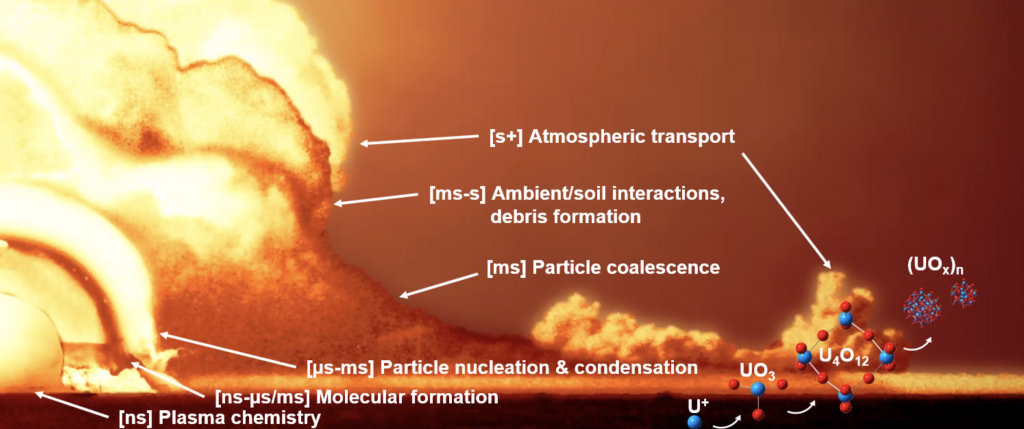Mikhail Finko, Ph.D. Candidate
Dr. Davide Curreli, Director of Research
January 12 11:00am – 1:00pm
Constraining Chemical Kinetics of Uranium Oxides in Extreme Environments
 ABSTRACT: Current understanding of metallic chemistry in extreme environments, such as nuclear fireballs, remains limited due to the multitude of physical processes and timescales involved. In particular, many chemical and plasma chemical reaction pathways responsible for forming uranium molecular species remain either unknown or unverified. In recent years, this longstanding knowledge gap has been the target of an increasing number of experimental characterizations, which this work aims to leverage to produce an updated model of uranium oxide (UOx) formation in extreme environments.
ABSTRACT: Current understanding of metallic chemistry in extreme environments, such as nuclear fireballs, remains limited due to the multitude of physical processes and timescales involved. In particular, many chemical and plasma chemical reaction pathways responsible for forming uranium molecular species remain either unknown or unverified. In recent years, this longstanding knowledge gap has been the target of an increasing number of experimental characterizations, which this work aims to leverage to produce an updated model of uranium oxide (UOx) formation in extreme environments.
To this end, a Monte Carlo Genetic Algorithm (MCGA) is utilized to calibrate a UOx reaction mechanism using measurements from a plasma flow reactor (PFR). In addition, laser ablation modeling capabilities are assessed for use in future chemical validation studies. These two systems cover a complimentary range of detonation-relevant flow regimes and cooling timescales. Bench-top laser ablation systems produce high temperature (>11,600 K) rapidly cooling (ns-µs) uranium plumes following laser-induced vaporization and shock expansion. The PFR, on the other hand, features a steady flow of uranium through a plasma torch (<10,000 K) cooling over longer (ms) timescales. The PFR is uniquely suited for the initial calibration of the reaction mechanism due to the relative ease of modeling the system. Thus, the MCGA optimization is limited to the PFR system in this work. Laser ablation, on the other hand, provides a potential test of the resulting mechanism over a wider range of detonation-relevant conditions. Performing such a test, however, requires first developing a predictive ablation model capable of capturing both the complex fluid dynamics and plasma chemistry of an ablation plume. Therefore, we evaluate the suitability of current modeling tools towards this problem and subsequently propose a coupled modeling approach for investigating ablation plume dynamics and chemistry. Lastly, synthetic diagnostics of emission and absorption spectroscopy signals are used to facilitate the characterization of both systems by enabling direct comparisons between simulations and measurements.
The optimization of a UOx reaction mechanism using PFR measurements is the primary scientific result of this work. The MCGA is used to identify dominant reaction channels and corresponding rate coefficients that produce the best agreement with available PFR data. The resulting reaction mechanism is compared against a previously constructed UOx mechanism, and differences in reaction rates and favorable reaction pathways are identified through a sensitivity analysis. Finally, recommendations for an updated UOx reaction mechanism are made, with considerations based on the limited constraining dataset.
The secondary scientific result of this work is the development of a one-way coupled radiation hydrodynamics and reactive CFD modeling approach for simulating ns duration pulsed laser ablation in reactive atmospheres. These simulations are used to study the interplay between fluid dynamics and chemistry in low-Z (aluminum and carbon) ablation plumes over ns to µs timescales. As a validation exercise, the ablation model results are compared against high fidelity plume imaging, time-of-flight expansion velocities, and spectroscopic molecular formation measurements. Reasonable agreement is observed across these comparisons and potential future refinements to the modeling approach are identified.